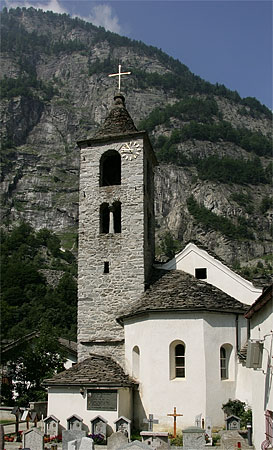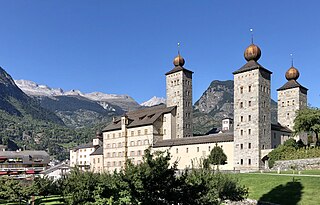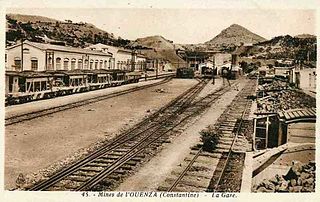
The Union Minière du Haut-Katanga was a Belgian mining company which controlled and operated the mining industry in the copperbelt region in the modern-day Democratic Republic of the Congo between 1906 and 1966.

The Simplon Tunnel is a railway tunnel on the Simplon railway that connects Brig, Switzerland and Domodossola, Italy, through the Alps, providing a shortcut under the Simplon Pass route. It is straight except for short curves at either end. It consists of two single-track tunnels built nearly 15 years apart. The first to be opened is 19,803 m (64,970 ft) long; the second is 19,824 m (65,039 ft) long, making it the longest railway tunnel in the world for most of the twentieth century, from 1906 until 1982, when the Daishimizu Tunnel opened.

Zwischbergen is a municipality in the district of Brig in the canton of Valais in Switzerland.

The Dunderland Line was a 23.7 km (14.7 mi) railway line between Gullsmedvik in the town of Mo i Rana and the village of Storforshei in Rana Municipality in Nordland county, Norway. Since 1942 the line has been part of the Nordland Line. The line was originally built and owned by Dunderland Iron Ore Company, which used it to freight iron ore from their mine at Storforshei to the port at Gullsmedvik.

Brig, officially Brig-Glis, is a historic town and municipality in the district of Brig in the canton of Valais in Switzerland. The current municipality was formed in 1972 through the merger of Brig (city), Brigerbad and Glis.
The Samira Hill Gold Mine is a gold mine in Téra Department of the Tillabéri Region in Niger. Opened in late 2004, it is the first industrial scale gold mine in the nation, and while operated by a Canadian/Moroccan consortia, the government of Niger owns both a 20% stake in its operation, and functions under government concession. The mine, and the possibility that other gold concessions will follow, is projected to be an important component of future export revenue for the West African state.
Venezuela is a major producer and exporter of minerals, notably bauxite, coal, gold, iron ore, and oil, and the state controls most of the country's vast mineral reserves. In 2003 estimated reserves of bauxite totaled 5.2 million tons.

The Lötschberg line is a railway in Switzerland, connecting Spiez in the canton of Bern with Brig in the canton of Valais. It crosses the Bernese Alps, from the Bernese Oberland to Upper Valais, through the Lötschberg Tunnel in the middle of the line. Together with the Simplon Tunnel south of Brig, it constitutes one of the major railways through the Alps and an important north-south axis in Europe. The Lötschberg axis is backed by the lower and longer Lötschberg Base Tunnel, part of the New Railway Links through the Alps project.

The Toi gold mine was an important gold mine during the Edo period in Japan, located within what is now part of the city of Izu, Shizuoka Prefecture in the middle of the Izu Peninsula. It remained in operation to the mid-twentieth century.
Mauritania's mineral sector was dominated by iron ore mining and beneficiation. Other mineral commodities produced in the country included cement, copper, gold, gypsum, petroleum, salt, and steel. The 'Ministère des Mines et de l’Industrie' was the Government agency responsible for enacting the Mining Code and for the coordination of all activities in the mining sector. The 'Direction des Mines et de la Géologie' was the entity responsible for promoting the mineral sector and for providing geologic and mining information to potential investors; the 'Direction des Hydrocarbures' was in charge of the development of the petroleum sector; and the 'Office Mauritanien des Recherches Géologiques' was the Government entity responsible for evaluating areas of mineral potential for exploration. The 'Société Nationale Industrielle et Minière (SNIM)' was responsible for iron ore production and benefciation.
Kilo-Moto is a region in the far northeast corner of the Democratic Republic of the Congo (DRC) where gold was discovered in the Ituri River by government prospectors in 1903. Moto is in the Haut-Uélé Province and Kilo in the Ituri Province.
The Bor mine is a large copper mine located in the east of Serbia in Bor District. Bor is one of the largest copper reserves in Serbia and in the world, having estimated reserves of 200 million tonnes of ore grading 1.5% copper. The area had been mined for gold as far back as at least the ancient Romans, but copper ore was only discovered, accidentally, in 1902.

In the industrial sector, the Luxembourg steel industry continues to occupy the first place in the country, even after the industrial reforms which have taken place since the 1960s.

The Société Mokta El Hadid was an iron ore mining company in Algeria, and later in other West African countries. From around 1865 until 1927 it was the largest mining company in Algeria, delivering ore of exceptional quality for processing in France. In 1878 the original Mokta El Hadid mine near Bône was said to be capable of supporting 25% of Europe's steel production. Before this mine was exhausted the company opened additional mines in Algeria. Later it extended its operations to countries such as Tunisia, Morocco, Niger, Côte-d'Ivoire and Madagascar, and mined manganese, chromium and uranium. In October 1970 the Société le Nickel, soon to become the Imétal holding company, took over the Mokta company. The company was later renamed Compagnie française de Mokta (CFM), specializing in uranium mining.

Denain-Anzin was a steel manufacturer in Denain and Anzin in the Nord department of France. The company was created through the merger of two smaller forges to produce rails for the Nord railway company. After World War II it was merged with other companies in 1948 to form Usinor.

The Société des mines et fonderies de Pontgibaud was a French silver and lead mining and smelting company based in Pontgibaud, Puy-de-Dôme. It mined lead-silver ore deposits that had been exploited since Roman times. Later it opened another factory in Couëron in the Loire estuary, and then closed down the Pontgibaud mines and foundry. The Pontgibaud factory in Couëron diversified into other non-ferrous metal products using imported ore. After being sold and resold it finally closed in 1988.

The Société de l'Ouenza was an Algerian iron ore mining company founded in 1913 and nationalized in 1966. It exploited rich deposits of high-quality ore at two sites in northeast Algeria near the Tunisian border. The ore was sent by rail to the port of Bône, then shipped to refineries in the UK, Europe and North America. At its peak it employed 4,000 workers who were housed in company towns.

The Société du Djebel-Djérissa (SDD) is a Tunisian iron ore mining company founded in 1899 that began operations in 1907. It produced up to 700,000 tons per year of hematite ore in the years before World War II. Production dropped during the war. The company was nationalized in 1961. Today levels of output are around 200,000 tons annually.
The Kibali Gold Mine is a combined open pit and underground gold mine in the Haut-Uélé province of the northeast Democratic Republic of the Congo. By area, it is one of the largest in Africa. The mine is named for the nearby Kibali River.
The Compagnie Minière des Grands-Lacs (MGL) was a Belgian mining company active in the Belgian Congo and then in the Democratic Republic of the Congo. It was established in 1923 and in 1976 merged with other companies into the Société Minière et Industrielle du Kivu (SOMINKI). The company was active in the eastern regions of Maniema and Kivu, with its main center at Kamituga in today's South Kivu. It extracted gold, tin and other minerals.

















